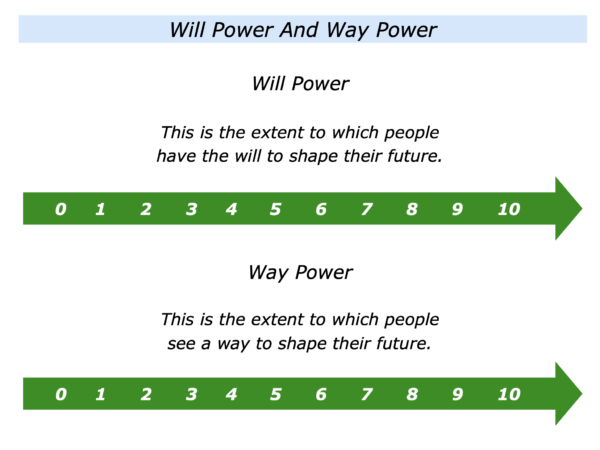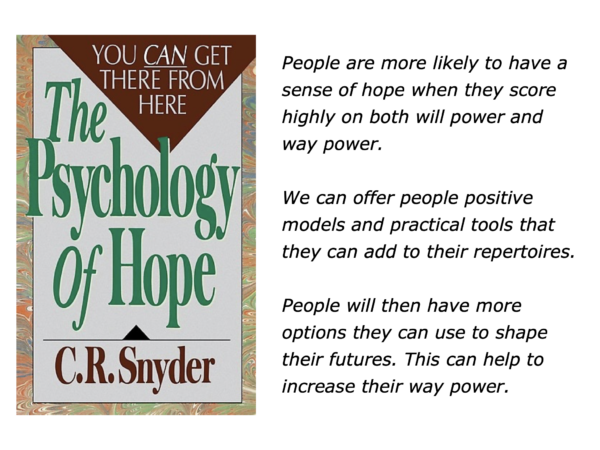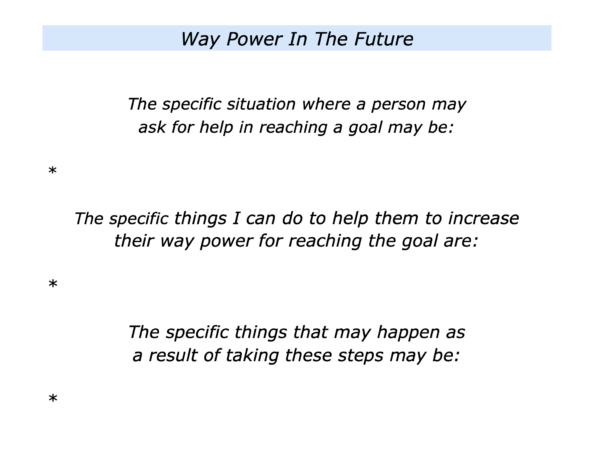
There are many ways to encourage people. One approach is to help them to increase their way power. This involves adding to their repertoire of options for reaching their goals.
Rick Snyder described this approach in his book The Psychology Of Hope. Here is one of the key messages he gave in the book.
People feel more able to shape their futures when they score highly on both will power and way power.
Let’s explore what which means in practice. Imagine that a person is facing a difficult challenge. They will have a strong sense of hope if, for example:
They score 8+/10 in terms of their will to solve the challenge;
They score 8+/10 in terms of seeing a way to solve the challenge.
The person will then feel confident about how to achieve their picture of success. This is because they score highly on both will power and way power.
This model also explains why a normally positive person can be confused if they feel depressed when facing a particular challenge. Their will power to solve the problem is 9+/10 but their present ability to see a way to solve it is perhaps 3/10.
Once the person sees a way to solve the problem, however, the cloud evaporates. Their way power goes up to 8+/10. Their sense of hope returns and they feel reinvigorated to tackle the challenge. Here are some of the key messages in The Psychology Of Hope.

Helping People To
Increase Their Way Power
Many people use this approach to encourage, educate and enable people in their daily lives and work. They pass on knowledge that helps others to increase their way power.
Good educators, for example, believe that education is the ultimate democratic activity. It offers people more choices – and therefore more freedom – to shape their future lives.
We are often told that: “Where there’s a will, there’s a way.”
But this phrase can be turned around to say: “Where there’s a way, there’s a will.”
If a person sees a way forward, they are more likely to develop the will to make it happen.
Let’s return to your own life and work. Imagine that person has asked for your help in reaching a goal. The person has the will to succeed. But they may need to add to their repertoire of options for working towards the goal.
What may be the situation where the person may ask for help? What may be the person’s goal? What may be the real results they want to achieve? What may be their picture of success?
What may be the person’s options for tackling the challenge? What may be the pluses and minuses of each option? What may be the other potential creative solutions?
Looking back, when has the person tackled a similar challenge successfully? What did they do right then? What were the principles they followed? How did they translate these into action?
When have other people tackled similar challenges successfully? What were the principles they followed? How can the person follow some of these principles in their own way?
What can you to increase the person’s way power? What are the positive models and practical tools you can pass on that may help them to tackle the challenge? How can you share this knowledge in a way the person can receive and use?
Let’s move on to the person’s action plan. What are the key strategies they can follow to give themselves the greatest chance of success? How can they translate these into action? What else can they do to increase the likelihood of achieving success?
If you wish, try tackling the exercise on this theme. This invites you to describe a situation where you may be able to increase a person’s way power. It invites you to complete the following sentences.







Leave a Reply